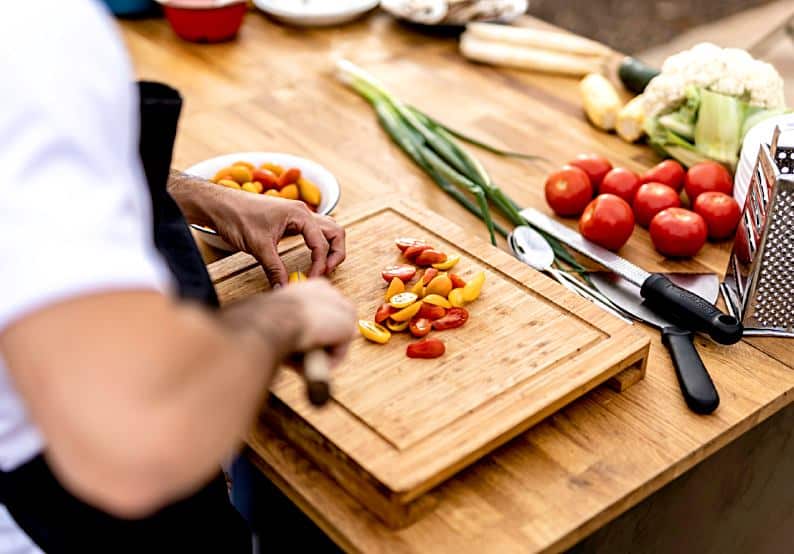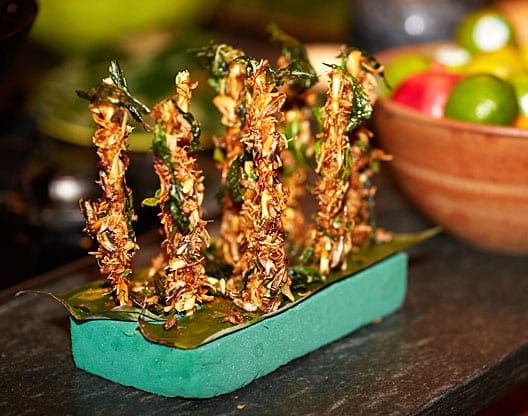Chef vs. Cook: Understanding the Key Differences
In the culinary world, “chef” and “cook” are often used interchangeably, but they represent distinct roles with different responsibilities. A cook typically refers to someone who prepares food according to established recipes and guidelines. Cooks can be found in various settings, from casual eateries to large restaurant kitchens, and their primary focus is on executing dishes efficiently and consistently.
On the other hand, a chef is a trained professional who prepares food, creates recipes, manages kitchen staff, and oversees the overall kitchen operations. Chefs are responsible for a restaurant’s culinary vision and often have formal training from culinary schools. Understanding this distinction helps one appreciate the skills and expertise that chefs bring to the kitchen.
Exploring Chef Hierarchies: The Brigade de Cuisine System
The brigade de cuisine, or kitchen brigade system, is a hierarchical structure for kitchen staff developed by the legendary French chef Auguste Escoffier. This system organises the kitchen into specific stations, each responsible for different aspects of meal preparation, ensuring efficiency and clarity in the culinary process.
Historically, the brigade system included roles such as the executive chef (chef de cuisine), sous chef, chef de partie (station chef), and various specialised positions like saucier (sauce chef) and pâtissier (pastry chef). Modern kitchens have adapted this system to suit contemporary needs, but the fundamental structure remains a cornerstone of professional kitchens worldwide, ensuring that each team member knows their responsibilities and can contribute effectively to the overall operation.
Diving into the Roles: Types of Chefs in Detail
Understanding the different types of chefs and their specific roles is crucial for anyone interested in the culinary arts. Here are some of the key positions within a professional kitchen:
- Executive Chef: At the top of the kitchen hierarchy, the executive chef is responsible for overall kitchen management, menu creation, and ensuring the quality and consistency of the dishes. They also handle administrative tasks such as budgeting and staff training. Becoming an executive chef typically involves extensive experience and education, often starting as line cook or sous chef.
- Sous Chef: The second in command, the sous chef, assists the executive chef in managing the kitchen and overseeing daily operations. This role involves supervising the kitchen staff, ensuring that food preparation meets the restaurant’s standards, and resolving any issues during service. Education and experience are crucial for this role, as sous chefs must be skilled in cooking and management.
- Chef de Partie (Station Chef): These chefs are responsible for specific stations within the kitchen, such as the grill, sauté, or pastry section. Specialisation allows chef de parties to develop expertise in their area, contributing to the overall quality and efficiency of the kitchen. For example, a pâtissier focuses on desserts and pastries, often having specialised training from a french pastry school.
By exploring these roles and the paths to achieving them, aspiring chefs can better understand the opportunities and challenges within the culinary profession.
Executive Chef: The Top of the Kitchen Hierarchy
The executive chef, often called the head chef, is the pinnacle of the kitchen hierarchy. This role involves a blend of culinary expertise, management skills, and creativity. The executive chef is responsible for crafting the menu, ensuring the quality and consistency of dishes, managing kitchen staff, and overseeing the overall kitchen operations.
Key responsibilities of an executive chef include:
- Menu Creation: Designing innovative and appealing menus that align with the restaurant’s concept and target audience.
- Quality Control: Ensuring that every dish meets the restaurant’s high standards regarding taste, presentation, and consistency.
- Staff Management: Hiring, training, and supervising kitchen staff to maintain a well-functioning and harmonious kitchen environment.
- Budgeting: Managing the kitchen’s budget, controlling food costs, and maximising profitability without compromising quality.
To become an executive chef, one typically starts in entry-level positions, gains extensive experience, and often pursues formal culinary education. Career progression involves roles like line cook and sous chef and then advancing to the executive chef position.
Sous Chef: The Second in Command
The sous chef plays a key role in supporting the executive chef and ensuring the kitchen runs smoothly. As the second in command, the sous chef is involved in both cooking and managerial tasks, acting as a bridge between the executive chef and the rest of the kitchen staff.
Key duties of a sous chef include:
- Supervision: Overseeing kitchen operations during service, ensuring all dishes are prepared to the required standards.
- Staff Coordination: Assigning tasks, managing schedules, and training kitchen staff.
- Quality Assurance: Tasting dishes, checking presentation, and ensuring consistency.
- Problem-Solving: Addressing any issues that arise during service, from equipment malfunctions to staff disputes.
Education and experience are vital for a sous chef role. Many sous chefs have attended culinary school and have several years of hands-on experience in various kitchen positions. This role requires a deep understanding of kitchen operations, strong leadership skills, and the ability to work under pressure.
Chef de Partie (Station Chef): Specialists Within the Kitchen
A chef de partie, or station chef, is responsible for running a specific section of the kitchen. This specialisation allows chefs to hone their skills in a particular area, contributing to the overall efficiency and quality of the kitchen.
Different stations include:
- Saucier (Sauce Chef): Prepares sauces, stews, and sautéed items.
- Poissonnier (Fish Chef): Handles fish and seafood dishes.
- Grillardin (Grill Chef): Manages grilled foods.
- Pâtissier (Pastry Chef): Focuses on desserts and baked goods.
Each station requires unique skills and knowledge. For instance, a pâtissier often undergoes specialized training at a french pastry school to master the art of pastry making.
Success as a chef de partie involves:
- Technical Skills: Mastery of techniques specific to their station.
- Attention to Detail: Ensuring every dish is prepared to perfection.
- Teamwork: Collaborating with other station chefs to ensure a seamless service.
By focusing on their specialized area, chefs de partie contribute significantly to the kitchen’s overall performance, ensuring that each dish served meets the high standards expected by diners.
Pastry Chef: The Sweet Side of the Kitchen
The pastry chef, or pâtissier, is a specialised chef responsible for creating desserts, pastries, and other baked goods. This role requires a unique set of skills and a deep understanding of baking techniques, flavors, and presentation.
Key responsibilities of a pastry chef include:
- Dessert Creation: Designing and preparing various desserts, from cakes and cookies to more intricate pastries and confections.
- Recipe Development: Experimenting with new flavours and techniques to create innovative desserts.
- Decoration: Focusing on the aesthetic aspect of desserts, ensuring they are visually appealing.
- Ingredient Sourcing: Selecting high-quality ingredients, often requiring specific items like chocolate, fruits, and speciality flours.
Pastry chefs often undergo specialised training at institutions like a French pastry school, where they learn the intricacies of pastry making. The role requires creativity, precision, and a passion for the art of desserts. Pastry chefs play a crucial role in shaping a restaurant’s sweet offerings, contributing to its overall reputation and customer satisfaction.
Additional Essential Roles: From Garde Manger to Commis Chef
Beyond the more commonly known chef positions, several other essential roles contribute to a well-functioning kitchen:
- Garde Manger (Pantry Chef): This role is responsible for cold dishes such as salads, appetisers, and charcuterie. It requires a keen eye for presentation and knowledge of various preservation techniques.
- Commis Chef: This is an entry-level position. The commis chef works under the chef de partie to learn the intricacies of different stations. This role is crucial for gaining hands-on experience and building a foundation for future advancement in the culinary hierarchy.
- Tournant (Relief Chef): A versatile chef who can work at any station. This role requires a broad skill set and adapting quickly to different tasks.
- Expeditor (Aboyeur): This role manages the flow of orders from the kitchen to the dining room, ensuring timely and accurate dish delivery. It is essential for maintaining smooth operations during busy service times.
These roles, though sometimes less glamorous, are vital to a kitchen’s success. Each position supports the overall operation, ensuring that every meal preparation and service aspect is executed seamlessly.
Marketing Your Business
Effective marketing is crucial for attracting and retaining customers in the culinary industry. Here are some strategies to consider:
- Social Media: Platforms like Instagram, Facebook, and Twitter are excellent for showcasing your dishes, sharing behind-the-scenes content, and engaging with customers. Consistent posting and interaction can build a loyal following and drive traffic to your business.
- Local Advertising: Invest in local advertising through newspapers, magazines, and radio stations to reach potential customers in your area. Sponsoring local events or participating in food festivals can also increase visibility.
- Partnerships and Events: Partner with other local businesses for cross-promotions or collaborative events. Hosting events such as cooking classes, tastings, or themed nights can attract new customers and create buzz around your business.
- Online Presence: Ensure your business has a professional website with up-to-date information about your menu, location, hours, and contact details. Encourage satisfied customers to leave positive reviews on platforms like Yelp and Google. Additionally, consider listing your business on food delivery apps to reach a broader audience.
By implementing these marketing strategies, you can effectively promote your culinary business, attract new customers, and build a loyal following.
Key Takeaways
- Understanding Roles: Recognising the difference between chefs and cooks is fundamental. Chefs are trained professionals responsible for creating recipes and managing kitchen operations, whereas cooks focus on preparing food according to set guidelines.
- Chef Hierarchies: The brigade de cuisine system organises kitchen roles to ensure efficiency and clarity. Understanding this hierarchy, from executive chefs to commis chefs, is essential for appreciating the structure and function of a professional kitchen.
- Specialised Positions: Each chef role, such as executive chef, sous chef, chef de partie, and pastry chef, has specific responsibilities and requires unique skills and training. Specialised training, like that from a french pastry school, can be crucial for certain positions.
- Supporting Roles: Essential but less discussed positions like garde manger, commis chef, tournament, and expeditor are vital in ensuring a kitchen operates smoothly and efficiently.
- Marketing Strategies: Effective marketing, including social media, local advertising, partnerships, events, and maintaining a strong online presence, is crucial for attracting and retaining customers in the culinary industry.
Understanding these aspects can help aspiring chefs and culinary entrepreneurs navigate their careers and build successful, well-managed culinary businesses.







